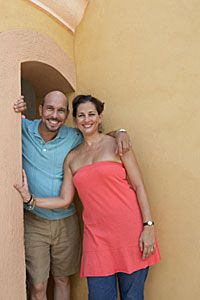Traditional Puerto Rican Clothing
When Columbus arrived with the Spanish at the end of the 15th century, they were all struck by how little the native Taíno people wore. Many were completely naked, while married women were expected to cover themselves with a simple apron or skirt. As the Spanish took over and began intermarrying with the local population, they also had them adopt Spanish dress. As a result, the clothing traditions of Puerto Rico are largely Spanish, but also with some African influence due to the slaves that were brought over.
Even though the European style of clothing -- with its layers and heavy materials like wool -- made less sense to the natives in the hot climate, adopting the customs of modesty was required by the new Christian religion they were to adopt. Even today, you'll find remnants of this tradition as some men still sport wool jackets [source: Martinez-Vergne]. Cotton, however, was a common material for clothing to deal with the hot weather.
Advertisement
Sometimes, however, the working conditions and not just modesty would dictate style. We spoke with Dr. Teresita Martinez-Vergne, who said that she wondered at why 19th-century men working in sugarcane fields would wear long-sleeved shirts that were buttoned to the top. She found in her research that this was because the sugarcane leaves are sharp enough to cut skin, and the shirts protected the men.
One clothing tradition that is still popular today is the guayabera shirt. This is a loose-fitting, button-up men's shirt that has multiple front pockets. Popular all over Latin America, historians are unsure of the exact country or date of origin. It is somewhere between a century and three centuries old. The shirt is generally considered suitable for most occasions, even formal situations, as it's also known as a "Mexican wedding shirt."
Even though many Puerto Ricans have adopted styles from the United States, performances of traditional dances will call for the dancers to wear traditional clothing. Long ruffled dresses of white or bright colors are common for these performances. For the bomba, one traditional dance, women wear a dress with a full skirt and petticoat, while men wear white pants and shirts as well as panama hats.
Related Articles
Sources
- CIA. "The World Factbook: Puerto Rico." Central Intelligence Agency. Last updated June 14, 2011. (Aug. 10, 2011) https://www.cia.gov/library/publications/the-world-factbook/geos/rq.html
- Encyclopædia Britannica. "Puerto Rico." Encyclopædia Britannica Online Academic Edition. Encyclopædia Britannica. 2011. (Aug. 10, 2011) http://www.britannica.com/EBchecked/topic/482879/Puerto-Rico
- Levy, Patricia, Nazry Bahrawi. "Puerto Rico." Marshall Cavendish. 2005. (Aug. 10, 2011) http://books.google.com/books?id=bGud6QTyXr4C
- Martinez-Vergne, Teresita, Ph.D. Personal correspondence. Aug. 8, 2011.
- Root, Regina. "The Latin American Fashion Reader." Berg. 2005. (Aug. 10, 2011) http://books.google.com/books?id=l8LNOJB7Z6UC
- Smith, Andrew F. "The Oxford Companion to American Food and Drink." Oxford University Press. 2007. (Aug. 10, 2011) http://books.google.com/books?id=AoWlCmNDA3QC
- Smithsonian.com. "Puerto Rico -- History and Heritage." Smithsonian.com. (Aug. 10, 2011) http://www.smithsonianmag.com/travel/destination-hunter/north-america/caribbean-atlantic/puerto-rico/puerto-rico-history-heritage.html
- Torres-Figueroa, Brenda. Institute of Puerto Rican Arts & Culture. Personal correspondence. Aug. 8, 2011.
